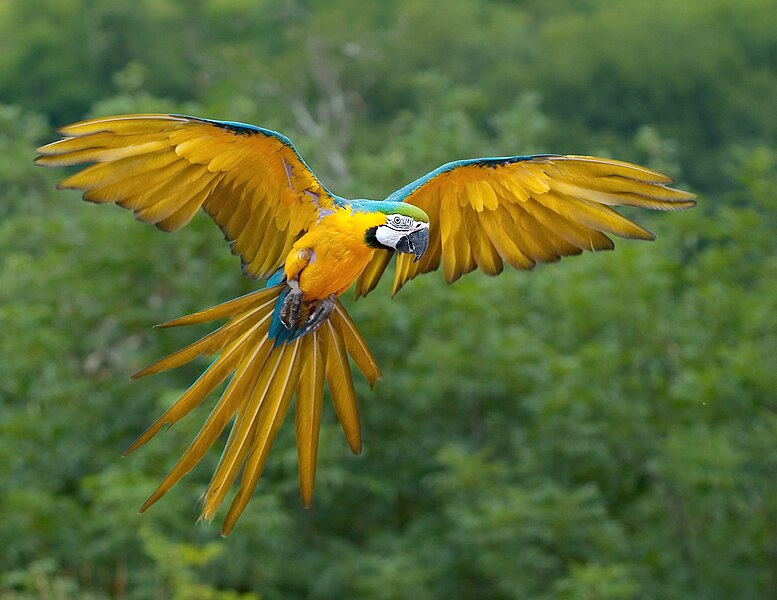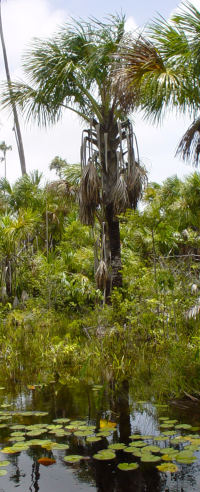 The huge, stunningly-colored Blue and Gold (or Blue and Yellow) Macaw, Ara ararauna, is one of the most recognizable of all birds…size, color, intelligence (and voice!) make it impossible to ignore. While it has long been bred in captivity, the natural history of this spectacular parrot is less-well known. Please read on to learn about its life in the wild and the threats to its continued existence.
The huge, stunningly-colored Blue and Gold (or Blue and Yellow) Macaw, Ara ararauna, is one of the most recognizable of all birds…size, color, intelligence (and voice!) make it impossible to ignore. While it has long been bred in captivity, the natural history of this spectacular parrot is less-well known. Please read on to learn about its life in the wild and the threats to its continued existence.
Range
The Blue and Gold has the largest natural range of any macaw. It is found from Eastern Panama east across most of Northern South America and south through Bolivia to Paraguay and Eastern Brazil. Despite this, it is declining or extinct in some areas…Trinidad’s macaws disappeared in the 1960’s, but a new population has been re-introduced.
Habitat
 This massive bird favors wooded areas near water, and is most frequently associated with palm swamps and forested river edges. Flocks roost together, and may fly great distances out into savannas and other habitats to feed each day. The dry season is spent within forests in some areas.
This massive bird favors wooded areas near water, and is most frequently associated with palm swamps and forested river edges. Flocks roost together, and may fly great distances out into savannas and other habitats to feed each day. The dry season is spent within forests in some areas.
Many populations are largely dependant upon the swamp-dwelling Aguaje Palm Tree (Mauritia flexuosa) for food and nesting sites. This relationship is cause for severe population declines in some regions…please see “Conservation”, below, for details.
Social Behavior and Breeding
Blue and Gold Macaws form strong pair bonds and often mate for life. Even within large flocks, pairs stay close together, with their wings nearly touching while in flight (I was able to observe this among wild Scarlet Macaws – pairs really are very obvious).
Breeding commences during the wet season – December to March – when food is most abundant. Pairs utilize tree hollows, and often nest near other flock members. They are extremely protective of their chicks…to the point that even long-term pets can become dangerously aggressive towards their owners.
Two or three eggs are produced at 2 day intervals, and hatch within 21-30 days. The female incubates, but the male will enter the nest if a threat appears. The young take a full 3 months to fledge, after which they are cared for by both parents for quite some time.
Conservation
Blue and Gold Macaws are threatened by habitat loss and, in some areas, hunting and collection for the pet trade. They are listed on Appendix II of CITES, but due to the large range, the IUCN classifies this species as of Least Concern.
However, studies have shown that the Blue and Gold Macaw has an extremely low breeding output, and that pairs do not breed each year. It is estimated that a breeding group of 100 adults produces, at most, 15-25 chicks annually. How many of these survive to become breeders themselves is unknown, but certainly far less than 100%.
As mentioned, a dependence on Aguaje Palm swamps (please see photo) places many populations at risk. The fruit of this tree is heavily utilized by people wherever it occurs. In the 1980’s, for example, residents of Iquitos, Peru consumed over 15 tons per day during some seasons! Unfortunately, the entire tree is usually cut down in order to harvest the fruit. Furthermore, dead palms, the only source of nesting cavities in many habitats, stand for only 4-7 years before falling to the ground. Nest site availability is therefore a serious concern.
Recent conservation efforts in Peru have focused on nest site creation (please see article below). The tops of selected Aguaje Palms were cut, and tree hollows generally formed and were occupied by macaws within 5-17 months. Each tree was calculated to have produced .7 chicks before falling. A carefully planned program of palm cutting, taking into account the needs of local people, macaws and other wildlife, and the surrounding swamp habitat, is being considered as a long-tern conservation technique.
Macaws as Pets
 Macaws are called “Flying Primates” by some, and the Blue and Gold is often considered to be the most curious, intelligent and affectionate of all. Its ability to mimic speech is also very impressive.
Macaws are called “Flying Primates” by some, and the Blue and Gold is often considered to be the most curious, intelligent and affectionate of all. Its ability to mimic speech is also very impressive.
However, macaw ownership should never be entered into lightly. Sadly, the demands they place upon owners are often not considered by the inexperienced. Despite their great qualities (and high price tag!), abandoned macaws of all kinds fill the holding cages of shelters and parrot rescue operations.
Further Reading
Conservation of the Blue and Gold Macaw in Peru
Observing Scarlet Macaws in Venezuela
Video: Rooftop Macaw Rescue
Blue and Gold macaw image referenced from wikipedia and originally posted by Luc Viatour
Blue and Gold macaw image referenced from wikipedia and originally posted by Luc Viatour
 That Bird Blog – Bird Care and History for Pet Birds
That Bird Blog – Bird Care and History for Pet Birds



